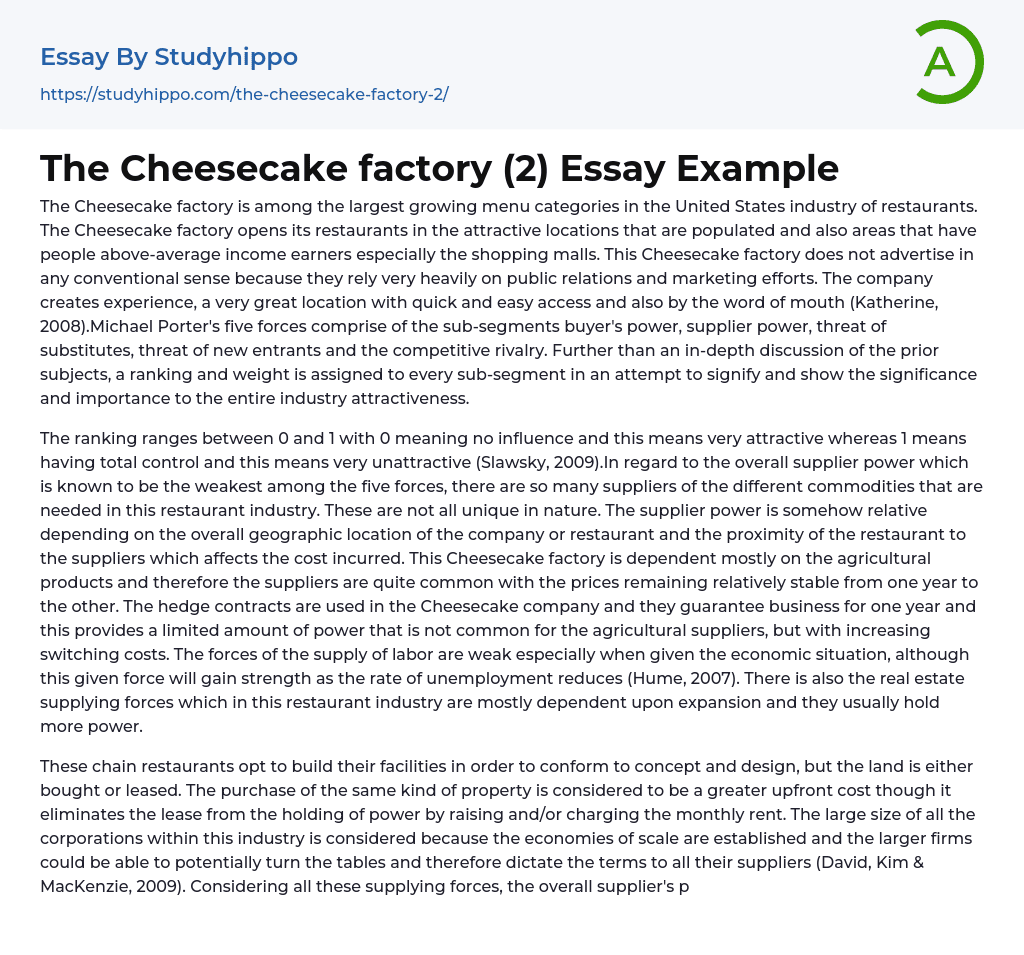The Cheesecake factory is experiencing rapid growth in the restaurant industry in the United States. They strategically position their restaurants in high population and above-average income areas, such as shopping malls. Rather than relying on traditional advertising, The Cheesecake Factory heavily relies on public relations and marketing efforts to attract customers. Their goal is to provide a memorable experience by offering convenient and easily accessible locations. Additionally, word-of-mouth also plays a significant role in their marketing strategy (Katherine, 2008).
Michael Porter's five forces framework evaluates buyer's power, supplier power, threat of substitutes, threat of new entrants, and competitive rivalry. A comprehensive analysis is conducted to determine the significance of each sub-segment and its impact on the overall attractiveness of the industry.
The ranking scale goes from 0 to 1. A ranking of 0 means
...no influence, which is very attractive, while a ranking of 1 means total control, which is very unattractive (Slawsky, 2009). The overall supplier power is considered the weakest among the five forces. There are numerous suppliers for various commodities in the restaurant industry. These suppliers are not all unique. The supplier power is relative and depends on the geographic location of the restaurant and its proximity to suppliers, which affects costs. The Cheesecake Factory relies heavily on agricultural products, so the suppliers are quite common and prices remain stable year after year. The company uses hedge contracts to guarantee business for a year, giving them limited power over agricultural suppliers, but with increasing switching costs. The labor supply has weak forces, particularly in current economic conditions, but will gain strength as unemployment decreases (Hume, 2007). Real estate supply forces hold more power in
the restaurant industry, mainly due to expansion opportunities.
These chain restaurants choose to construct their facilities to conform to a specific concept and design, but they acquire the land either through purchase or lease. While purchasing the property of the same type incurs a higher upfront cost, it eliminates the need for monthly rent payments. The large size of these corporations within the industry provides them with economies of scale, allowing the possibility for them to gain control and influence over their suppliers. Considering these factors, the overall power of the suppliers is ranked as a 10 out of 1 (David, Kim & MacKenzie, 2009).
Another factor to consider is the power of the buyers. In the case of the Cheesecake Factory, the buyers consist of ordinary citizens who do not collectively possess enough power to significantly impact prices. There is no individual buyer or group of buyers that purchases a substantial amount of cheesecake to dictate terms or prices. Additionally, buyers have more power compared to suppliers due to high fixed costs, which can affect profitability and sales when there are a significant number of buyers (Karen & John, 2008).
The Cheesecake Factory depends on macroeconomic factors, which give buyers more power. The restaurant industry is highly competitive, resulting in a high level of rivalry among competitors. The Cheesecake Factory has locations in both metropolitan and urban areas, but it needs a significant customer base. However, these customers can also be found in less populated areas. The restaurants have a high density and offer similar services and products, making them subject to customer scrutiny. Customers tend to frequent the restaurants that provide the best value. Larger
restaurants have a slight advantage because of economies of scale, enabling them to advertise more frequently, develop unique products, and access competitive technology. This advantage is rated 0.25 out of 1.
The threat of substitutes is the highest among the five forces, primarily due to the frequent availability of substitutes. These substitutes are not limited to the restaurant industry, but also include any form of home-prepared meals. To counteract this, the Cheesecake Factory often utilizes a differentiation strategy and relies on its unique atmosphere to offer products that cannot be easily duplicated. According to Hume (2007), this threat is rated at 0.30 out of 1. Additionally, there is also the threat of new entry into the restaurant industry. The entry barriers are low, with small operators accounting for 91% of all restaurants, as reported by the National Restaurant Association.
Despite the impediments of intense competition and substantial fixed costs, a significant number of entrepreneurs still venture into the industry due to the promise of substantial profits from incremental sales beyond the breakeven point. Additionally, the prevalence of franchised businesses in this sector is a common occurrence. Furthermore, major chain restaurants benefit from advantages such as advertising, economies of scale, advanced technology, and superior purchasing power in real estate. According to Hume (2007), this force is ranked at 0.22 out of 1.
- Chief Executive Officer essays
- Convenience Store essays
- Firm essays
- Training And Development essays
- Unilever essays
- Variable Cost essays
- Virgin Group essays
- Bargaining essays
- Entity essays
- Pest analysis essays
- John Locke essays
- 9/11 essays
- A Good Teacher essays
- A Healthy Diet essays
- A Modest Proposal essays
- A&P essays
- Academic Achievement essays
- Achievement essays
- Achieving goals essays
- Admission essays
- Advantages And Disadvantages Of Internet essays
- Alcoholic drinks essays
- Ammonia essays
- Analytical essays
- Ancient Olympic Games essays
- APA essays
- Arabian Peninsula essays
- Argument essays
- Argumentative essays
- Art essays
- Atlantic Ocean essays
- Auto-ethnography essays
- Autobiography essays
- Ballad essays
- Batman essays
- Binge Eating essays
- Black Power Movement essays
- Blogger essays
- Body Mass Index essays
- Book I Want a Wife essays
- Boycott essays
- Breastfeeding essays
- Bulimia Nervosa essays
- Business essays
- Business Process essays
- Canterbury essays
- Carbonate essays
- Catalina de Erauso essays
- Cause and Effect essays
- Cesar Chavez essays




